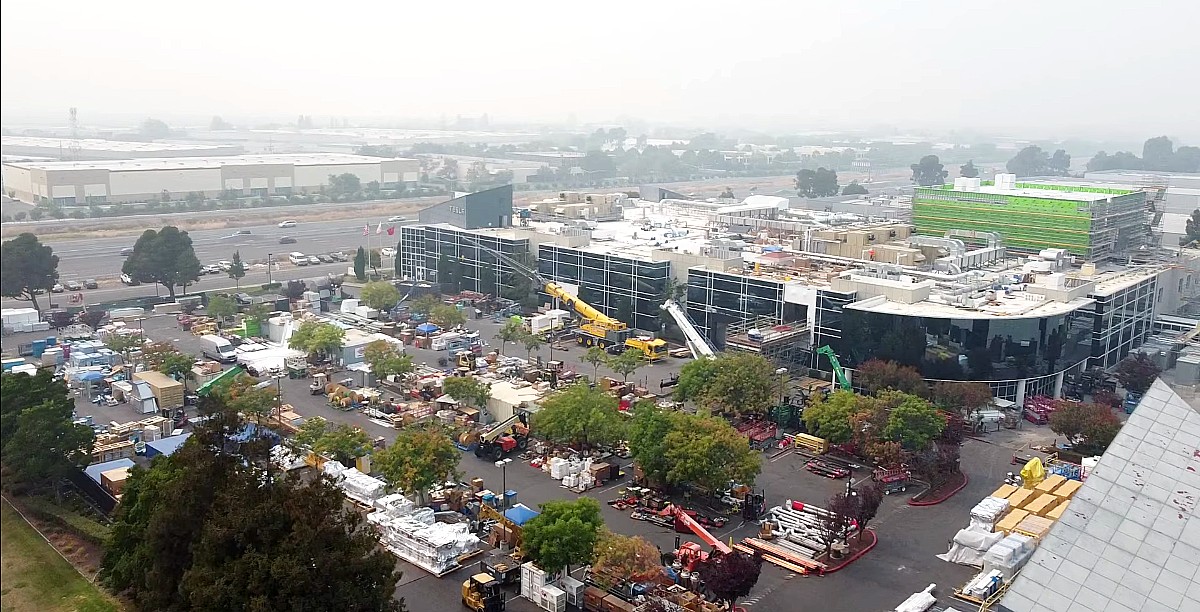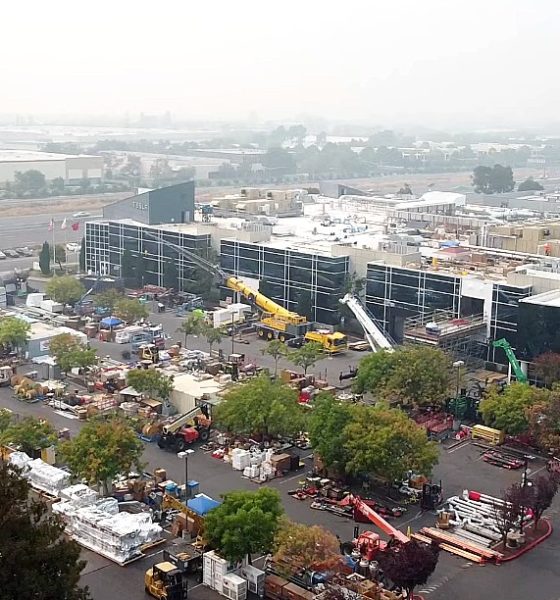

News
Tesla’s ‘Roadrunner’ facility gets a neighbor working on tech beyond the million-mile battery
As the wait for Tesla’s Battery Day continues, more and more speculations are abounding about what the electric car maker might reveal during the highly-anticipated event. Elon Musk has stated that Battery Day’s announcements will be mind-blowing, and based on apparent clues recently observed by the Tesla community, it appears that the CEO may be right on the money.
Recent reports have indicated that Amprius, a battery company currently working on silicon nanowire tech, recently relocated its headquarters to a site that’s just a few hundred feet away from Tesla’s Roadrunner battery facility in Kato Road, Fremont. Considering the firm’s focus, its new headquarters’ rather convenient location, and Elon Musk’s previous references to the use of silicon in batteries, there seems to be a fair chance that Amprius’ move to Fremont may be more than a coincidence.
Amprius notes that it is working on creating silicon nanowires for battery anodes that dramatically improve battery weight and density. The company’s website notes that silicon generally has about 10x the capacity of graphite (carbon), but it has a big drawback in the way that it swells when it’s charged, causing the silicon to fracture. To address this, Amprius utilizes silicon nanowires, which keeps the silicon from fracturing and breaking apart even when it swells.
As noted by EV enthusiast and YouTube host Driving Delta, Elon Musk himself appears to be teasing the use of advanced silicon tech on Twitter last month. In one of his posts, Musk shared some lyrics of the song “Lithium” by Nirvana, whose refrain includes sections that state “I’m not gonna crack.” Granted, Musk may simply be trolling the Tesla community with his posts, but it should be noted that he also talked about the increasing use of silicon anodes five years ago.
“We’re shifting the cell chemistry for the upgrade battery pack to partially use silicon in the anode. This is just a sort of baby step in the direction of using silicon in the anode. We’re still primarily using synthetic graphite, but over time, we’ll be using increasing amounts of silicon in the anode,” Musk noted during a 2015 conference call.
As noted by Amprius’ on its website, the use of 100% silicon paves the way for batteries with the highest energy density, perhaps even at the 500 Wh/kg level. That’s enough to start exploring electric VTOL projects, a topic that Elon Musk has admitted is something that truly interests him. That being said, Professor in Energy Materials and Technologies Ying Shirley Meng, who has made significant contributions to Maxwell Technologies’ battery tech herself, believes that challenges still remain in the use of silicon nanowires.
“We should pay attention to the cost per kg. Even (if) those nanowires work (which I doubt), to produce consistent quality in metric ton scale at 10$ per kg it will be sci-fi for now,” she noted.
Elon Musk, for his part, recently stated that the technology that could allow 400 Wh/kg with a high life cycle and volume production is not too far away. Musk gave a rough timeframe for the technology, stating that such milestones could be achieved in about three to four years.
Tesla’s Battery Day event is expected to introduce the company’s next-generation lithium-ion cells, though speculations suggest that these batteries — which are expected to last a million miles — are based largely on Maxwell Technologies’ dry electrode tech. Maxwell itself has previously noted that it could offer batteries with 300 Wh/kg while stating that it had also identified a path to 500 Wh/kg. With this in mind, it appears that Tesla may already be setting the stage for cells that will likely go even beyond the million-mile battery.
Granted, Amprius’ move to Fremont may be unconnected to Tesla. That being said, the two companies’ goals to align with each other, and Elon Musk’s own references to the use of silicon suggests that Tesla will likely get a lot of value from Amprius’ tech. If speculations prove true, the path to batteries that go even further than the million-mile mark may be feasible in the near future. Such innovations are key to Tesla’s goal of accelerating the transition to sustainable energy, after all.
Watch these recent takes on the Amprius rumors in the videos below.

News
Tesla FSD fleet is nearing 7 billion total miles, including 2.5 billion city miles
As can be seen on Tesla’s official FSD webpage, vehicles equipped with the system have now navigated over 6.99 billion miles.

Tesla’s Full Self-Driving (Supervised) fleet is closing in on almost 7 billion total miles driven, as per data posted by the company on its official FSD webpage.
These figures hint at the massive scale of data fueling Tesla’s rapid FSD improvements, which have been quite notable as of late.
FSD mileage milestones
As can be seen on Tesla’s official FSD webpage, vehicles equipped with the system have now navigated over 6.99 billion miles. Tesla owner and avid FSD tester Whole Mars Catalog also shared a screenshot indicating that from the nearly 7 billion miles traveled by the FSD fleet, more than 2.5 billion miles were driven inside cities.
City miles are particularly valuable for complex urban scenarios like unprotected turns, pedestrian interactions, and traffic lights. This is also the difference-maker for FSD, as only complex solutions, such as Waymo’s self-driving taxis, operate similarly on inner-city streets. And even then, incidents such as the San Francisco blackouts have proven challenging for sensor-rich vehicles like Waymos.
Tesla’s data edge
Tesla has a number of advantages in the autonomous vehicle sector, one of which is the size of its fleet and the number of vehicles training FSD on real-world roads. Tesla’s nearly 7 billion FSD miles then allow the company to roll out updates that make its vehicles behave like they are being driven by experienced drivers, even if they are operating on their own.
So notable are Tesla’s improvements to FSD that NVIDIA Director of Robotics Jim Fan, after experiencing FSD v14, noted that the system is the first AI that passes what he described as a “Physical Turing Test.”
“Despite knowing exactly how robot learning works, I still find it magical watching the steering wheel turn by itself. First it feels surreal, next it becomes routine. Then, like the smartphone, taking it away actively hurts. This is how humanity gets rewired and glued to god-like technologies,” Fan wrote in a post on X.
News
Tesla starts showing how FSD will change lives in Europe
Local officials tested the system on narrow country roads and were impressed by FSD’s smooth, human-like driving, with some calling the service a game-changer for everyday life in areas that are far from urban centers.

Tesla has launched Europe’s first public shuttle service using Full Self-Driving (Supervised) in the rural Eifelkreis Bitburg-Prüm region of Germany, demonstrating how the technology can restore independence and mobility for people who struggle with limited transport options.
Local officials tested the system on narrow country roads and were impressed by FSD’s smooth, human-like driving, with some calling the service a game-changer for everyday life in areas that are far from urban centers.
Officials see real impact on rural residents
Arzfeld Mayor Johannes Kuhl and District Administrator Andreas Kruppert personally tested the Tesla shuttle service. This allowed them to see just how well FSD navigated winding lanes and rural roads confidently. Kruppert said, “Autonomous driving sounds like science fiction to many, but we simply see here that it works totally well in rural regions too.” Kuhl, for his part, also noted that FSD “feels like a very experienced driver.”
The pilot complements the area’s “Citizen Bus” program, which provides on-demand rides for elderly residents who can no longer drive themselves. Tesla Europe shared a video of a demonstration of the service, highlighting how FSD gives people their freedom back, even in places where public transport is not as prevalent.
What the Ministry for Economic Affairs and Transport says
Rhineland-Palatinate’s Minister Daniela Schmitt supported the project, praising the collaboration that made this “first of its kind in Europe” possible. As per the ministry, the rural rollout for the service shows FSD’s potential beyond major cities, and it delivers tangible benefits like grocery runs, doctor visits, and social connections for isolated residents.
“Reliable and flexible mobility is especially vital in rural areas. With the launch of a shuttle service using self-driving vehicles (FSD supervised) by Tesla in the Eifelkreis Bitburg-Prüm, an innovative pilot project is now getting underway that complements local community bus services. It is the first project of its kind in Europe.
“The result is a real gain for rural mobility: greater accessibility, more flexibility and tangible benefits for everyday life. A strong signal for innovation, cooperation and future-oriented mobility beyond urban centers,” the ministry wrote in a LinkedIn post.
News
Tesla China quietly posts Robotaxi-related job listing
Tesla China is currently seeking a Low Voltage Electrical Engineer to work on circuit board design for the company’s autonomous vehicles.

Tesla has posted a new job listing in Shanghai explicitly tied to its Robotaxi program, fueling speculation that the company is preparing to launch its dedicated autonomous ride-hailing service in China.
As noted in the listing, Tesla China is currently seeking a Low Voltage Electrical Engineer to work on circuit board design for the company’s autonomous vehicles.
Robotaxi-specific role
The listing, which was shared on social media platform X by industry watcher @tslaming, suggested that Tesla China is looking to fill the role urgently. The job listing itself specifically mentions that the person hired for the role will be working on the Low Voltage Hardware team, which would design the circuit boards that would serve as the nervous system of the Robotaxi.
Key tasks for the role, as indicated in the job listing, include collaboration with PCB layout, firmware, mechanical, program management, and validation teams, among other responsibilities. The role is based in Shanghai.
China Robotaxi launch
China represents a massive potential market for robotaxis, with its dense urban centers and supportive policies in select cities. Tesla has limited permission to roll out FSD in the country, though despite this, its vehicles have been hailed as among the best in the market when it comes to autonomous features. So far, at least, it appears that China supports Tesla’s FSD and Robotaxi rollout.
This was hinted at in November, when Tesla brought the Cybercab to the 8th China International Import Expo (CIIE) in Shanghai, marking the first time that the autonomous two-seater was brought to the Asia-Pacific region. The vehicle, despite not having a release date in China, received a significant amount of interest among the event’s attendees.








